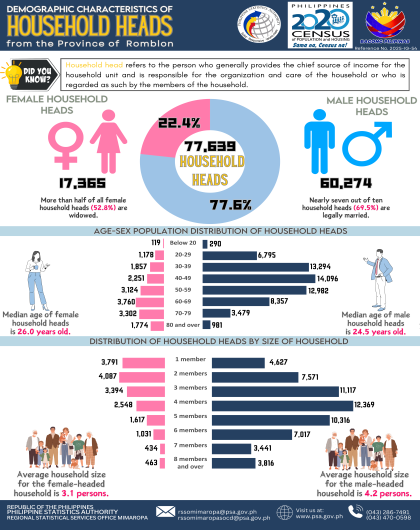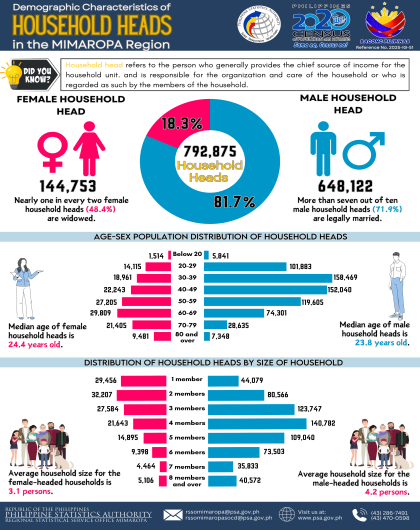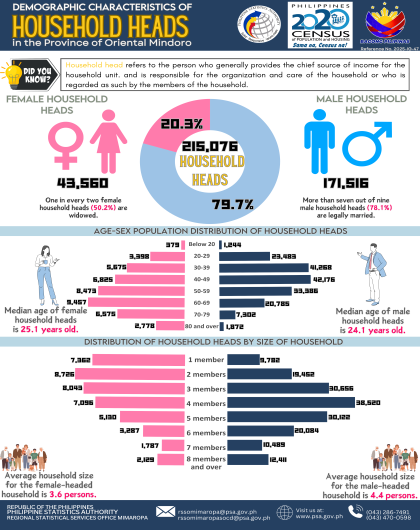SPECIAL RELEASE
Land Ownership in Bansud, Oriental Mindoro
(2020 Census of Population and Housing)
33.5 percent households in Bansud, Oriental Mindoro own other land
Based on the 2020 Census of Population and Housing (2020 CPH), 3,353 households or 33.5 percent of the total 10,003 households in Bansud, Oriental Mindoro reported that they own at least one type of land apart from the land that they own/occupy at the time of the census.
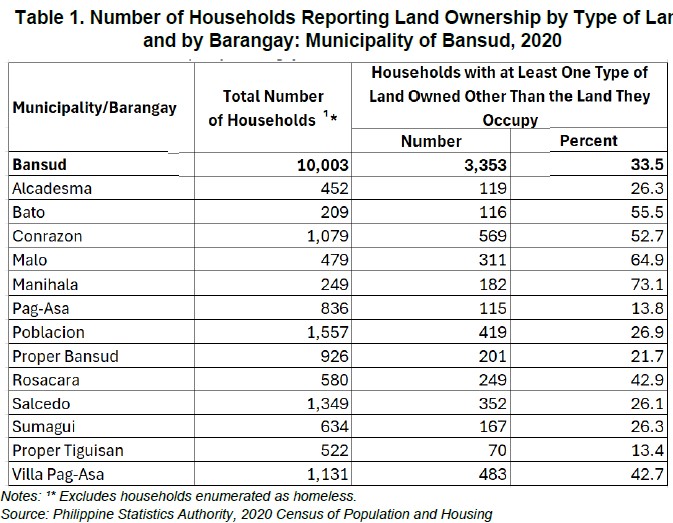
Among the 13 barangays of Bansud, Oriental Mindoro, Barangay Manihala had the highest proportion of households with at least one type of land they owned other than the land they occupy, with 73.1 percent or 182 households. It was followed by Barangay Malo with 64.9 percent or 311 households, and Barangay Bato with 55.5 percent or 116 households.
Meanwhile, Barangay Proper Tiguisan had the lowest proportion of households with at least one type of land they owned other than the land they occupy with 13.4 percent or 70 households.
26.6 percent households in Bansud, Oriental Mindoro own agricultural land/s
Of the total 10,003 households, 2,663 (26.6 percent) were reported to own agricultural land/s. Households that owned other residential land/s totaled to 1,369 (13.7 percent) while households that owned agricultural land/s acquired through the Comprehensive Agrarian Reform Program (CARP), as agrarian reform beneficiary reached 393 (3.9 percenr). Only 24 households (0.2 percent) had members that owned other types of land/s.
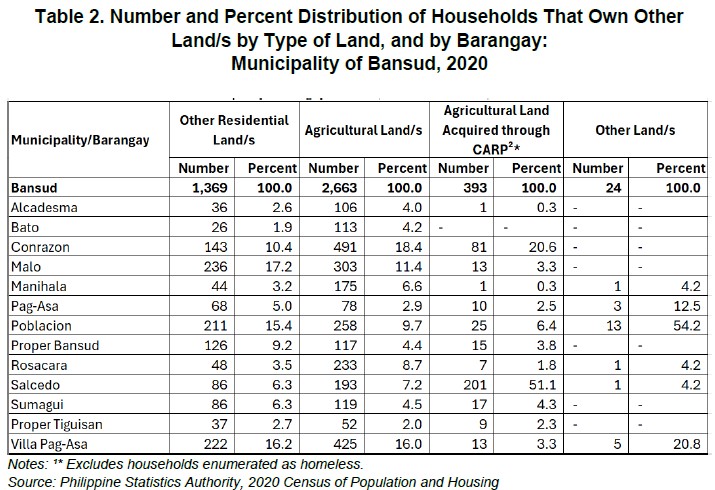
Barangay Malo posts the highest number of households that own residential lands
Barangay Malo posted the highest number of households that own residential lands, with 236 households, or 17.2 percent of the total 10,003 households that own residential lands in Bansud, Oriental Mindoro.
Among the 13 barangays with the highest number of households that own residential lands were Barangay Malo with 236 households (17.2 percent), Barangay Villa Pag-asa with 222 households (16.2 percent), Barangay Poblacion with 211 households (15.4 percent), Barangay Conrazon with 143 households (10.4 percent), and Barangay Proper Bansud with 126 (9.2 percent) of the total households that own residential lands in Bansud, Oriental Mindoro.
On the other hand, Barangay Bato recorded the fewest households that own residential lands in the municipality, with 26 households (1.9 percent ).
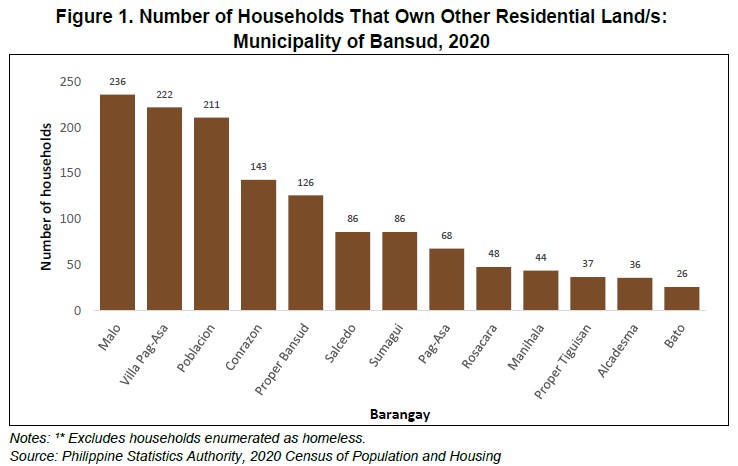
Number of households that own agricultural lands were highest in Barangay Conrazon
The Barangay of Conrazon had the highest number of households that own agricultural lands with 491 households or 18.4 percent of the total number of households that own agricultural land in Bansud, Oriental Mindoro.
It was followed by Barangay Villa Pag-asa, with 425 households (16.0 percent), and Barangay Malo with 303 households (11.4 percent).
Ownership of agricultural lands was least in Barangay Proper Tiguisan with 52 households (2.0 percent) in the municipality.
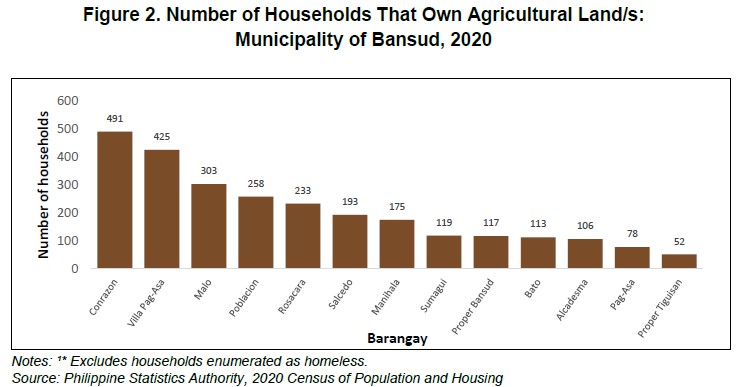
Ownership of agricultural lands acquired through CARP is most common in Barangay Salcedo
The highest number of households that own agricultural lands acquired through the Comprehensive Agrarian Reform Program (CARP) in Bansud, Oriental Mindoro was registered in Barangay Salcedo with 201 households or 51.1 percent. It was followed by the Barangay Conrazon with 81 households (20.6 percent), and Barangay Poblacion with 25 households (6.4 percent).
Only Barangay Bato reported no recorded number of households that owned agricultural lands acquired through CARP.
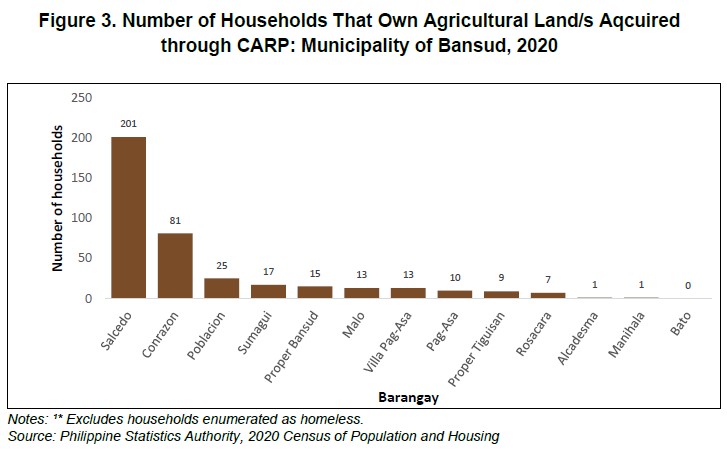
Barangay Poblacion registers the biggest number of households that own other types of land
The number of households that own other types of land was highest in Barangay Poblacion, with 13 households, or 54.2 percent of the total number of households owning other types of land in the municipality of Bansud, Oriental Mindoro. Other types of land include those used for commercial, industrial, or recreational purposes. This was followed by Barangay Villa Pag-asa with 5 households (20.8 percent), Barangay Pag-asa with 3 households (12.5 percent), Barangays Manihala, Rosacara, and Salcedo, each with 1 household (4.2 percent).
The remaining barangays had no recorded households that owned other types of land.
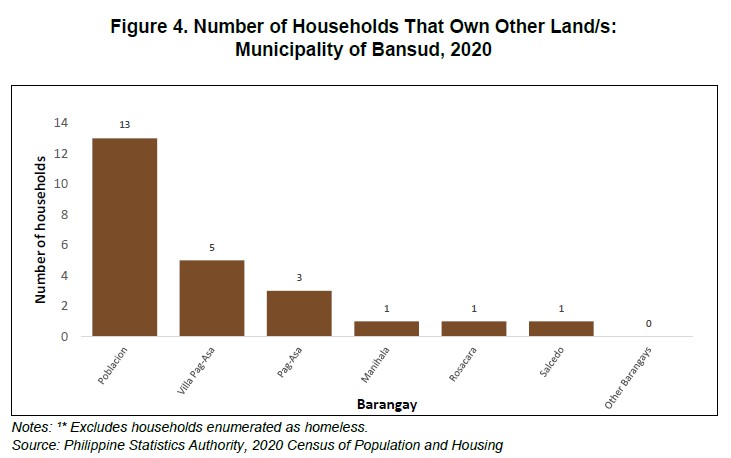
The statistics presented in this report were based on the information provided by the respondent or any responsible household member who may provide accurate answers to the questions and give correct information about the household. Moreover, the number of households in this report excludes households enumerated as homeless.
In the 2020 CPH, data on the land ownership were collected by asking the respondents, “Does any member of this household own the following?
1. Other residential land/s;
2. Agricultural land/s;
3. Agricultural land/s acquired through Comprehensive Agrarian Reform Program, as an agrarian reform beneficiary;
4. Other land/s.
(SGD) CHARLYN ROMERO-CANTOS, PhD
(Chief Administrative Officer)
Officer-in-Charge
Oriental Mindoro Provincial Statistical Office
MJHD
TECHNICAL NOTES
The population and housing censuses in the Philippines are conducted on a “de jure” basis, wherein a person is counted in the usual place of residence or the place where the person usually resides. The enumeration of the population and collection of pertinent data in the 2020 CPH referred to all living persons as of 01 May 2020.
For land ownership in the 2020 CPH, the respondent was asked, “Does any member of this household own the following...?” This determines if the household has any member/s who own other lands aside from the one that the household is currently occupying. The data were collected using the CPH Form 2 (Common Household Questionnaire).
DEFINITION OF TERMS
Household is a social unit consisting of a person or a group of persons who sleep in the same housing unit and have a common arrangement in the preparation and consumption of food.
Agricultural Land/s refers to land/s devoted to or suitable for the cultivation of the soil, planting of crops, growing of trees, raising of livestock, poultry, fish, or aquaculture production, including the harvesting of such farm products, and other farm activities and practices performed in conjunction with such farming operations by persons whether natural or juridical and not classified by law as mineral land, forest land, residential land, commercial land, and industrial land.
Residential Land/s refers to All lands that have been identified and zoned as residential through the appropriate ordinance by the Local Government Unit (LGU) having jurisdiction over the area. These include residential lands within areas zoned as mixed residential and commercial or mixed residential and industrial (Source: RA 10023, Series of 2010).
Other Residential Land refers to residential lands that the household owns other than the one they are occupying.
Other Land/s include commercial lands, industrial lands, ancestral domains, and ancestral lands. The last two categories are distinguished from Torrens Title and other tenurial instruments granted by a government agency or by the court.
Agricultural land/s, acquired through Comprehensive Agrarian Reform Program, Agrarian Reform Beneficiary pertains to land ownership acquired through Emancipation Patent (EP) Holder, Certificate of Land Ownership Award (CLOA), and
Homestead Patent (HP), Leasehold Contract (LC).


